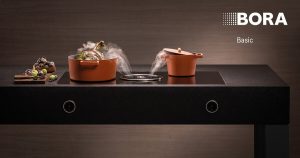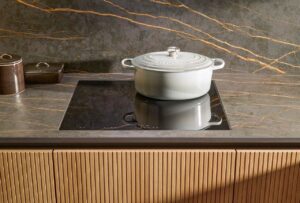Why choose an induction hob?

Firstly though, what is an induction hob and how does it differ from gas or a traditional electric hob?
An induction hob is only activated when switched on and a ferrous metal pan is placed on it. The pan completes the electrical circuit and begins a rapid, even transference of heat to the base of the pan and its contents. It does need special pans with a ferrous steel, but they are easily available on the high street and many of your existing pans may work – just see if a magnet sticks to the bottom of them. If it does, they’re suitable.
What are the benefits?
Seven reasons to choose induction
- It’s efficient!
Induction hobs provide one of the most efficient methods of cooking.
- It’s fast, very fast!
With the ability to accurately and quickly control the power.
induction hobs contain a strong electromagnet positioned under the surface of the hob, so wherever the pan touches the hob gets heated equally.

- It’s safer
Induction hobs contain a system that detects when a pan is in place meaning no heat is produced when the hob is empty and there is no flame or element to ignite fumes or cause burns. Whilst it does have some residual heat when turned off, it is no where near as hot as other heating methods.
- Extended cooking zones for larger pans
Some induction hobs have extended cooking zones that break the boundaries of the usual four area hob. This allows you to use less traditional pots or dishes such as a teppanyaki or griddle plate.
- Easy to clean
Induction hobs have a completely flat surface meaning they are easier to clean and maintain with no gaps to hide spills or crumbs.
- Greener
Induction cooking is more efficient than traditional methods as heat is channelled into the pan itself, cooking the food faster and using less power.
- No overhead extractor (some models)
New technology means that many of the new induction hobs have in built extraction, pulling steam and aromas away at the point of production. This means no cooking smells in your home and a better design for your kitchen.